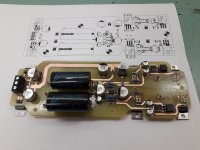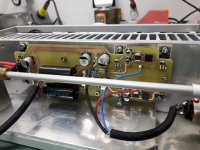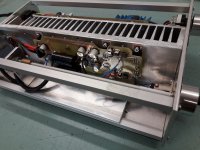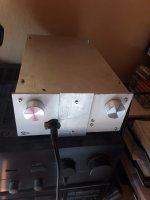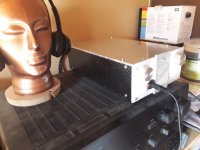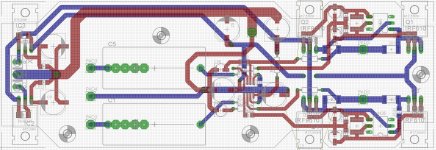Almost my same setup: chord Qutest fed into the Whammy which drives an ACA v1 at 5W. Sounds glorious!
Indeed!

"WHAMMY" Pass DIY headphone amp guide
First SMD Whammy had some problems in Soundquality no way to find the reason.
So what to do?
Make a PCP redesign take it apart, put it together again and since some weeks it plays 😀
A little painting is still to do but this can wait.
First SMD Whammy had some problems in Soundquality no way to find the reason.
So what to do?
Make a PCP redesign take it apart, put it together again and since some weeks it plays 😀
A little painting is still to do but this can wait.
Attachments
Built the Whammy with the understanding that it would handle most headphones. I have some 600 ohm AKG Sextetts that sound pretty flat with the Whammy. All of my vintage receivers/integrated amps kind of destroy the Whammy for sound. Not sure if there is anything that I can do to modify it to improve this. On the other hand, since I have all of this other equipment, probably not necessary.
Have you tried any other headphones? It probably works a bit better on lower impedance units but should work on most 600 cans.
Hi Wayne,
Have used the Whammy with:
Sennheiser HD25 (70 ohms)
Audeze LCD-2 (70 ohms)
Beyerdynamic DT770 (80 ohms)
Sennheiser HD58x Precision (150 ohms)
Sennheiser HD250 Linear (300 ohms)
Whammy sounds good with all of the above. The sextetts sound better when using the headphone out on a Pioneer SA-7500 and sound really good with a Pioneer SX-3800.
Cheers,
Les
Have used the Whammy with:
Sennheiser HD25 (70 ohms)
Audeze LCD-2 (70 ohms)
Beyerdynamic DT770 (80 ohms)
Sennheiser HD58x Precision (150 ohms)
Sennheiser HD250 Linear (300 ohms)
Whammy sounds good with all of the above. The sextetts sound better when using the headphone out on a Pioneer SA-7500 and sound really good with a Pioneer SX-3800.
Cheers,
Les
I have used:
OPA627 (with adapter for 2X mono)
OPA2107
OPA2134
LM4562
and am currently using 2X LME49990
OPA627 (with adapter for 2X mono)
OPA2107
OPA2134
LM4562
and am currently using 2X LME49990
I have used:
OPA627 (with adapter for 2X mono)
OPA2107
OPA2134
LM4562
and am currently using 2X LME49990
OPAMP doesn't "see" your headphones as a load. If you are having trouble driving your headphones with the whammy you are just not getting enough juice. your headphones are not very easy to drive. They have a super high impedance for headphones AND they have one of the lowest sensitivities I've seen in a while as well. I think one solution might be to bais the output mosfets a little hotter. Im not exactly sure how to do this but it involves the optocoupler circuit and R18 (R30). you may need someone else smarter than i to give you specifics. And you may want bigger heat sinks on those output FETs.
OPAMP doesn't "see" your headphones as a load./QUOTE]
Doh, yeah, this makes sense. Ignore my earlier comment. 🙂
"WHAMMY" Pass DIY headphone amp guide
First SMD Whammy had some problems in Soundquality no way to find the reason.
So what to do?
Make a PCP redesign take it apart, put it together again and since some weeks it plays 😀
A little painting is still to do but this can wait.
Wow, great looking board Danger Mouse! Any chance you can share a 1:1 pdf for etching? Is it single layer? I know everyone is into small order pcb fabrication these days (including me) but I still have a few bottles of FeCl in the garage and a 24"x24" sheet of FR4, photo paper and a laser printer from 2002 that does great toner transfers.

Finally took some time to try different OPAMPs in my Whammy. Below is the list in order of preference. Somewhat subjective as I knew what I was putting in before listening. I listened for sibilance, bass structure, and overall balance and detail. They were very close and would be happy with the top six.
OPA1612 (SOIC on adapter)
LM49720
OPA1642 (SOIC on adapter)
OPA2604
MUSES 8820
OPA2134 (my original)
LM4562
MUSES 8920, based on poor performance likely fake from EBay HK seller.
Leaving the OPA1612 in. Fun exercise and practice soldering SOIC to adapters.
OPA1612 (SOIC on adapter)
LM49720
OPA1642 (SOIC on adapter)
OPA2604
MUSES 8820
OPA2134 (my original)
LM4562
MUSES 8920, based on poor performance likely fake from EBay HK seller.
Leaving the OPA1612 in. Fun exercise and practice soldering SOIC to adapters.
Leaving the OPA1612 in. Fun exercise and practice soldering SOIC to adapters.
What voltage does the OPA1612 see in your build? I also agree that the OPA1612 is the best sounding out of the bunch I've tested (aside from the Burson V6 Classic). I was a bit worried about the opamp seeing +/-16V, but it seems it can actually handle 36V looking at its spec sheet, so maybe I shouldn't worry about it afterall. 🙂
I wonder how hot the OPA1612 gets at 16V, and if a heatsink starts to become beneficial. Probably just nervosa... 😛
Last edited:
FYI, PartsConnexion has discrete op-amps from New ClassD ($67) and SparkOS ($60), and I've tried them both. I don't have a firm view about how they compare to the Burson Classic, but I'm quite happy with both of them. They are certainly worth checking out for anyone who wants to keep rolling...
Burson V6 classic
Good afternoon,
as others before, I was asked by Burson, if I liked to review their discrete opamps and write about it in an honest way on a platform/thread of my choice. Out of curiosity I agreed and asked for a V6 classic. I thought, this might be the one for me.
My Whammy served me for having a lot of enjoyable hours of music, I post my findings here in this thread and hope it may give a worthwhile contribution. Within this thread there are numerous proposals for opamps that are considered to sound good in this amp and over time I collected a few of them.
Let me say upfront, my findings are of truly subjective nature and reflect my personal experience with all these equipment applied to my ears. What I noticed and probably most of you have experience with, is the day to day variance of perception and - of course the expectation bias, which is high with the Bursons [emoji6]. This is hard to overcome. My attempt to do so is, listening to a few tracks in a kind of concentrated way in order to get some details and later change to just listening without special notice to anything except the music. After this I know if I like, what I hear, or not, and, while repeating this later again and taking some notes regarding a few criteria. During all sessions the volume knob stayed untouched.
My source was Qobuz stream with USB bridge as a transport. The first DAC I used was the Topping E30, powered by an IFI Ipower 5V and the second one was Miro’s great AD1862 DAC in combination with JLsounds usb2i2s board. For my ears the AD1862 is livelier, more natural, crisper, yet without fatigue and therefor more fun to listen to.
The amp was my Whammy with Fairchild mosfets, 18 V transformer, 15V regulators – lifted to almost 17V by LEDs. This was no issue for the V6c, because due to its current consumption R35 brought the voltage down to a for the Burson acceptable value.
AKG K371 closed back headphones were used for listening. It has got strong and deep bass, has got good really good mids, yet prominent heights, which I tamed by a small passive inline filter. This filter makes it a very enjoyable and a pretty good HIFI headphone.
Music: 44.1/16 streamed from Qobuz.
Titles I have choosen:
Light my Fire and Let it Rain / Patricia Parker
The Painter / Sara K.
Hy Heart Is Full / Norah Jones
Take Me Home / Holly Cole
Dawn Patrol and Isla / Portico Quartet
Crooked Tree / Sting and Shaggy
Sweet Burden (Live) / Chilly Gonzales
New Orleans / Sarah McCoy
Beethoven Symphony No.7 / Freiburger Barockorchester
Chesky Records Guide to Critical Listening – the whole album
I had the following opamps available:
LM4562, Discrete Chifi HDAM, opa2604, LM833, JRC2114, RC4580, opa1612, opa1622, opa2134, LM49990, Burson V6 Classic.
Out of the monolitic opamps, for me the LM49990 and the opa1622 were the most pleasing in terms of great controlled bass, good mids, delicate highs, very good voices, natural instruments, airy stage and fully dynamic presentation. No opamp was really disappointing, not even the very cheap JRC2114. The Chifi HDAM was playing too warm for me in the mentioned chain. The opa1612 gave me an unpleasant amount of hiss, so I had to expel it. But where was the Burson? In the first listening I was somehow surprised by it. This was not a step forward in terms of sound; rather a step back from the opamps of my choice. And I started to think about how I could write about that. Would I play this down? No, I wouldn’t. Burson asked for an honest review, so they would get one, I said to myself. A bit scared, how I would find the right words….
The next round was done with the opa1622, the LM49990, the monolitic winners of the first round and the Burson V6c.
While in the first round I always again went through the mentioned titles, in order to select the most suitable opamps for my ears, I decided for the second round to reduce the listenig to the Chesky album alone. I made a criteria matrix, which contained the terms, resolution, depth, atmosphere, midrange purity, naturalness, presence, rhythm & pace, focus, imaging, transients, bass resonance, dynamic, Piano, acoustic bass, voices, violins, guitar, trumpet and percussion and decided to give marks from 1 to 5.
The first one, opa1622 was a great pleasure to listen to. For atmosphere and naturalness I could give just 3, but all other criteria got a 4 and my overall rating for the opa1622 was 4 out of 5.
The LM49990 gave me a bad surprise, as I couldn’t listen to it in the second round because of it showed the same hiss, the opa1612 had shown from the very beginning. I tried a lot in order to remove this hiss, as I knew, it was not there in the beginning. No chance, even in its original setup with the E30. ? Any idea?
And now the Burson. It has been playing quite a few hours up to now and I took care of letting it warm up before listening. I was really curious, if it could better the opa1622. And, to my surprise it could do in any way. In my matrix there were just found twice the rating 4 - for "depth" and "midrange purity". All other critria were marked with the highest rating. It was 2 steps up vs. itself in the first audition and it was a clear step up against the opa1622. So I gave the Burson V6 classic the rating 5 out of 5; dynamic, delicate, with a good sense of depth, fantastic voices, rhytm&pace. A toe tipping experience. It will stay in my Whammy.
If anybody had an idea in terms of the hissing opa1612 and LM49990 I would be happy to hear it. Thanks.
Cheers, Ernst
PS: some pics
View attachment 950702View attachment 950703View attachment 950704
Good afternoon,
as others before, I was asked by Burson, if I liked to review their discrete opamps and write about it in an honest way on a platform/thread of my choice. Out of curiosity I agreed and asked for a V6 classic. I thought, this might be the one for me.
My Whammy served me for having a lot of enjoyable hours of music, I post my findings here in this thread and hope it may give a worthwhile contribution. Within this thread there are numerous proposals for opamps that are considered to sound good in this amp and over time I collected a few of them.
Let me say upfront, my findings are of truly subjective nature and reflect my personal experience with all these equipment applied to my ears. What I noticed and probably most of you have experience with, is the day to day variance of perception and - of course the expectation bias, which is high with the Bursons [emoji6]. This is hard to overcome. My attempt to do so is, listening to a few tracks in a kind of concentrated way in order to get some details and later change to just listening without special notice to anything except the music. After this I know if I like, what I hear, or not, and, while repeating this later again and taking some notes regarding a few criteria. During all sessions the volume knob stayed untouched.
My source was Qobuz stream with USB bridge as a transport. The first DAC I used was the Topping E30, powered by an IFI Ipower 5V and the second one was Miro’s great AD1862 DAC in combination with JLsounds usb2i2s board. For my ears the AD1862 is livelier, more natural, crisper, yet without fatigue and therefor more fun to listen to.
The amp was my Whammy with Fairchild mosfets, 18 V transformer, 15V regulators – lifted to almost 17V by LEDs. This was no issue for the V6c, because due to its current consumption R35 brought the voltage down to a for the Burson acceptable value.
AKG K371 closed back headphones were used for listening. It has got strong and deep bass, has got good really good mids, yet prominent heights, which I tamed by a small passive inline filter. This filter makes it a very enjoyable and a pretty good HIFI headphone.
Music: 44.1/16 streamed from Qobuz.
Titles I have choosen:
Light my Fire and Let it Rain / Patricia Parker
The Painter / Sara K.
Hy Heart Is Full / Norah Jones
Take Me Home / Holly Cole
Dawn Patrol and Isla / Portico Quartet
Crooked Tree / Sting and Shaggy
Sweet Burden (Live) / Chilly Gonzales
New Orleans / Sarah McCoy
Beethoven Symphony No.7 / Freiburger Barockorchester
Chesky Records Guide to Critical Listening – the whole album
I had the following opamps available:
LM4562, Discrete Chifi HDAM, opa2604, LM833, JRC2114, RC4580, opa1612, opa1622, opa2134, LM49990, Burson V6 Classic.
Out of the monolitic opamps, for me the LM49990 and the opa1622 were the most pleasing in terms of great controlled bass, good mids, delicate highs, very good voices, natural instruments, airy stage and fully dynamic presentation. No opamp was really disappointing, not even the very cheap JRC2114. The Chifi HDAM was playing too warm for me in the mentioned chain. The opa1612 gave me an unpleasant amount of hiss, so I had to expel it. But where was the Burson? In the first listening I was somehow surprised by it. This was not a step forward in terms of sound; rather a step back from the opamps of my choice. And I started to think about how I could write about that. Would I play this down? No, I wouldn’t. Burson asked for an honest review, so they would get one, I said to myself. A bit scared, how I would find the right words….
The next round was done with the opa1622, the LM49990, the monolitic winners of the first round and the Burson V6c.
While in the first round I always again went through the mentioned titles, in order to select the most suitable opamps for my ears, I decided for the second round to reduce the listenig to the Chesky album alone. I made a criteria matrix, which contained the terms, resolution, depth, atmosphere, midrange purity, naturalness, presence, rhythm & pace, focus, imaging, transients, bass resonance, dynamic, Piano, acoustic bass, voices, violins, guitar, trumpet and percussion and decided to give marks from 1 to 5.
The first one, opa1622 was a great pleasure to listen to. For atmosphere and naturalness I could give just 3, but all other criteria got a 4 and my overall rating for the opa1622 was 4 out of 5.
The LM49990 gave me a bad surprise, as I couldn’t listen to it in the second round because of it showed the same hiss, the opa1612 had shown from the very beginning. I tried a lot in order to remove this hiss, as I knew, it was not there in the beginning. No chance, even in its original setup with the E30. ? Any idea?
And now the Burson. It has been playing quite a few hours up to now and I took care of letting it warm up before listening. I was really curious, if it could better the opa1622. And, to my surprise it could do in any way. In my matrix there were just found twice the rating 4 - for "depth" and "midrange purity". All other critria were marked with the highest rating. It was 2 steps up vs. itself in the first audition and it was a clear step up against the opa1622. So I gave the Burson V6 classic the rating 5 out of 5; dynamic, delicate, with a good sense of depth, fantastic voices, rhytm&pace. A toe tipping experience. It will stay in my Whammy.
If anybody had an idea in terms of the hissing opa1612 and LM49990 I would be happy to hear it. Thanks.
Cheers, Ernst
PS: some pics
View attachment 950702View attachment 950703View attachment 950704
Last edited:
Just to agree: I have not tried a whole boatload of monolithic op-amps. Just a $1 TI and an $10 Analog Devices. But the Burson (and the SparkOS and the New ClassD I mentioned a couple posts back) are all heads and shoulders above them. They take the Whammy to another level entirely.
An audiophile friend of mine (Robert) had another audiophile friend of his over the other day. He was curious about Robert's headphone amp. (It's a Whammy I built with a redwood case.) So he sat down and had a listen. He was sufficiently impressed to want one for himself.
It's a remarkable amp.
It's a remarkable amp.
Wow, great looking board Danger Mouse! Any chance you can share a 1:1 pdf for etching? Is it single layer? I know everyone is into small order pcb fabrication these days (including me) but I still have a few bottles of FeCl in the garage and a 24"x24" sheet of FR4, photo paper and a laser printer from 2002 that does great toner transfers.

It is double Layer. I`ve done mine with toner transfer method.
If you are still interested i will share some PDF`s
Attachments
Raspberry Pi + DAC power supply
Hi all -
My first post here. I cheated and purchased a pre-build WHAMMY with the intention of using it as a gateway to learning my way around building my own amp. I am considering modifying it as a first step. I would like to try adding a raspberry pi and DAC card to the amp to make it a network streamer/DAC/amp.
In a perfect world, I would be able to share the power supply to power both cards and the amp, but my guess is that won't actually work and a better option is to create another AC circuit and getting a decent switch power supply for the pi.
Any thoughts would be appreciated... Thanks
Hi all -
My first post here. I cheated and purchased a pre-build WHAMMY with the intention of using it as a gateway to learning my way around building my own amp. I am considering modifying it as a first step. I would like to try adding a raspberry pi and DAC card to the amp to make it a network streamer/DAC/amp.
In a perfect world, I would be able to share the power supply to power both cards and the amp, but my guess is that won't actually work and a better option is to create another AC circuit and getting a decent switch power supply for the pi.
Any thoughts would be appreciated... Thanks
Welcome Ks47104!
I have that setup, but separated components. Depending on your model, the RPi requires 5.1v and about 3A. Is this for a 'simplified' box or just a learning exercise? The RPi inside a case would have to expose it's connectors to be useful, but since it has connectors / slots on all 4 sides, that makes it a challenge. You may need to build in extensors, internal connectors, etc. And with a HAT DAC, another bit of the same.
So I really think it's a hard sell to try to make it all together.
Look what this guys had to do only to fit the streamer inside a case:
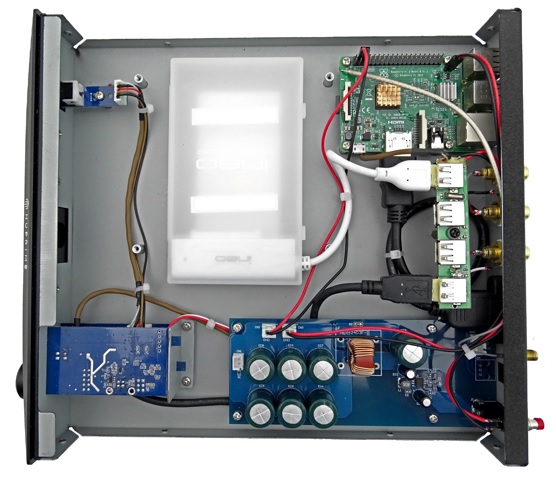

And the DAC in that streamer (left bottom board) is about a quarter of the area of the Whammy. And you still to put the DAC on top of the RPi.
Heck, it's an interesting project, but you are getting into muddy waters! Really interested to see what comes out of your idea!
Rafa.
I have that setup, but separated components. Depending on your model, the RPi requires 5.1v and about 3A. Is this for a 'simplified' box or just a learning exercise? The RPi inside a case would have to expose it's connectors to be useful, but since it has connectors / slots on all 4 sides, that makes it a challenge. You may need to build in extensors, internal connectors, etc. And with a HAT DAC, another bit of the same.
So I really think it's a hard sell to try to make it all together.
Look what this guys had to do only to fit the streamer inside a case:
And the DAC in that streamer (left bottom board) is about a quarter of the area of the Whammy. And you still to put the DAC on top of the RPi.
Heck, it's an interesting project, but you are getting into muddy waters! Really interested to see what comes out of your idea!
Rafa.
I tend to agree with Rafa about the oddities of putting a raspberry pi in a case. The connections on every side make it tough.
My own opinion is that putting a computer/dac in the same case as an amplifier might cause too much electrical noise to bleed into the amplifier. My Pi and ACA are on different shelves to separate them in an attempt to keep noise down.
My own opinion is that putting a computer/dac in the same case as an amplifier might cause too much electrical noise to bleed into the amplifier. My Pi and ACA are on different shelves to separate them in an attempt to keep noise down.
- Home
- Amplifiers
- Pass Labs
- "WHAMMY" Pass DIY headphone amp guide
